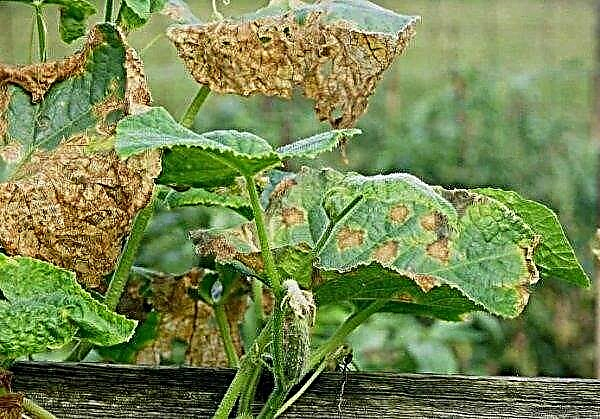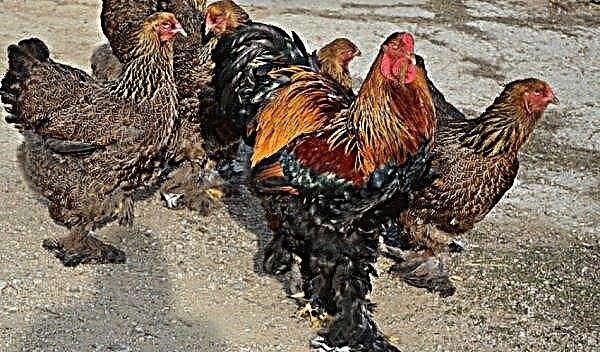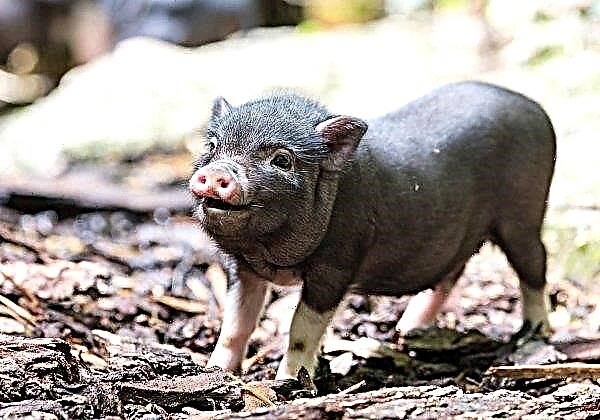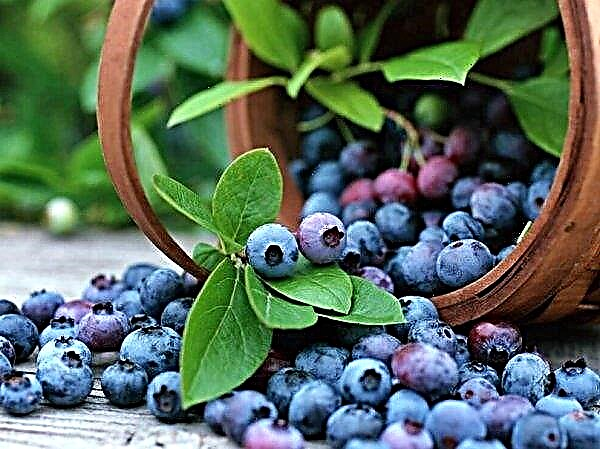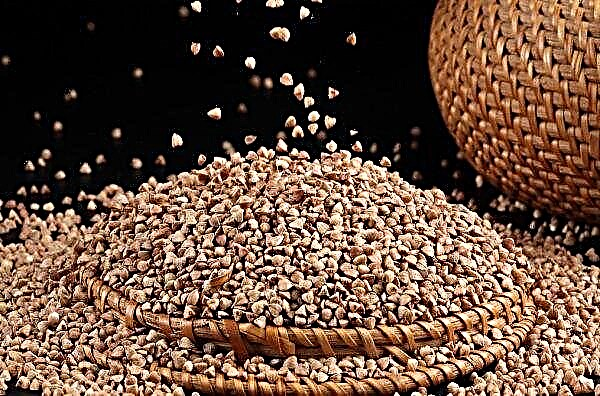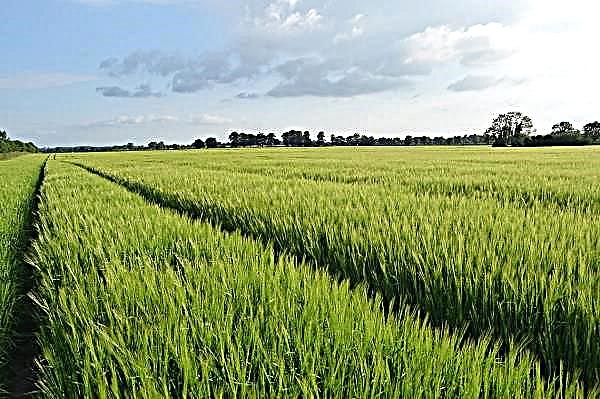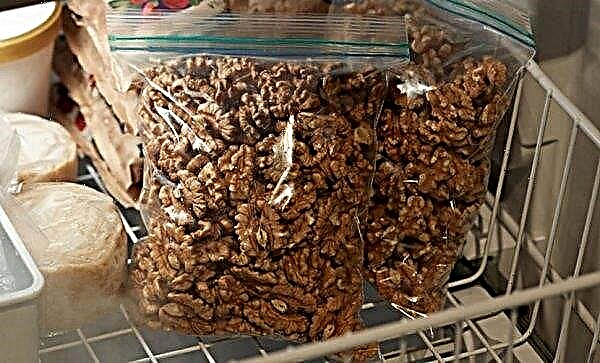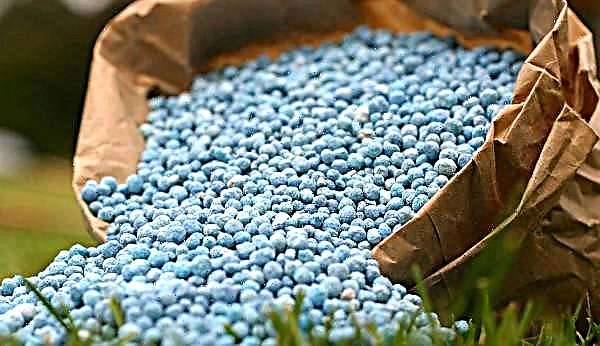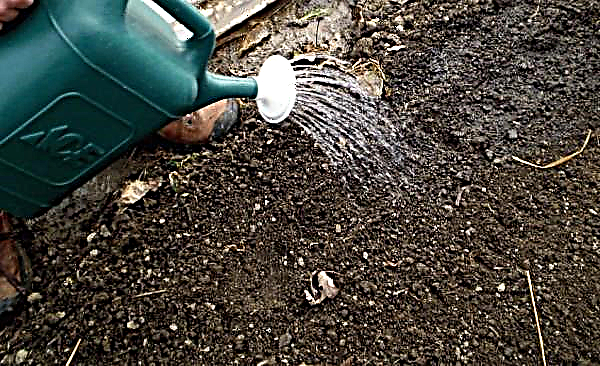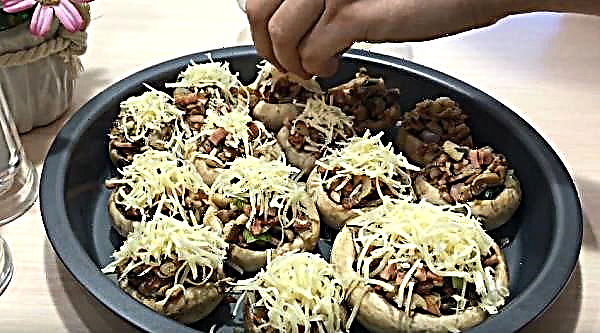Tomato King of the Giants is a young variety, but in less than ten years he managed to gain fame and love gardeners. From the article you will learn how the tomato managed to become a favorite, what features are inherent in the variety, how to grow such a tomato on the land, and what rules for plant care must be observed in order to get an excellent crop.
History and selection
The Russian breeders worked on the cultivation of the King of Giants variety, and in 2010 their efforts were officially confirmed - the variety received state registration.
Often, work on the creation of the King of giants is attributed to Siberian breeders, but this fact is not confirmed by official sources. The reason for this opinion could be Russian companies distributing tomato seeds, including Ural summer resident, Siberian Garden, and NK Russian Garden. Ukrainian and Belarusian producers also sell seeds of this variety.Did you know? For the first time in the territory of European countries, tomato appeared in the 16th century thanks to Christopher Columbus. Two centuries later, the vegetable came to our territory and was used as an ornamental plant, because the crop did not have time to ripen due to low temperatures.
Grade description
Before buying the King of giants, you need to familiarize yourself with its description, information about the yield, distinguishing characteristics and appearance of the plant, which the manufacturer claims. This will help to determine whether the variety is suitable specifically for your purposes.

Tomato The king of giants is often referred to as universal varieties, the fruits of which can be used in cooking, but this is not so. This variety belongs to salad, and it is advisable to use it fresh. Heat treatment does not affect the taste of tomatoes, however, significantly affects the density of the fruit. The pulp of a tomato becomes soft, it can even begin to fall apart, which is why it is worthwhile to use the variety in conservation when making lecho, tomato juice and pasta, or sauces.
For the preservation of whole tomatoes, this variety is not suitable, because its fruits are too large. But it is worth noting that a later harvest will be smaller, and vegetables obtained during the late ripening period will be a good alternative.Important! Often, producers intentionally overestimate the yield and weight of the fruit, so you should focus on the average.
Botanical characteristics
Tomato refers to indeterminate (tall) - the bush reaches a height of 200 cm when grown in a greenhouse, or 160 cm if the plant is in open ground. The stems are brittle and thin as for a variety with large-sized fruits. For this reason, the bushes need to be tied. The name of the variety describes the main distinguishing feature - the size of the fruit. One tomato can reach a weight of 850 kg. The average weight is 400-600 grams.

Tomatoes have a dense skin of saturated red color. Fruits are rounded and slightly flattened. At the base of the stalk there is a ribbing. The fruit pulp is juicy, dense, has a rich aroma and taste - sweet, with a slight sourness. Better The king of giants is developing in the southern regions.
Advantages and disadvantages
- The positive features of the King of giants include:
- high productivity;
- rich taste of fruits;
- unpretentiousness to growing conditions;
- large sizes of fruits;
- the possibility of long-term storage of tomatoes;
- resistance to transportation, preservation of a trade dress;
- high germination of planting material - up to 98%;
- ability to tolerate picking and transplanting without consequences;
- ripening uniformity - there are no yellow or greenish spots on the fruits;
- resistance to minor changes in climatic conditions, in particular, temperature;
- the possibility of independent procurement of planting material;
- universality of application in cooking;
- tomato resistance to typical pests and diseases.
Important! Tomato can be grown from seeds obtained from the previous harvest for 2-3 years. After it is advisable to update the planting stock with seeds from a trusted store.
- Among the minuses of tomato distinguish:
- susceptibility to attack of whiteflies, usually greenhouse;
- moodiness - a lot of time needs to be paid to plant care;
- the need for mandatory tying bushes.
Self-growing seedlings
The king of giants will also grow a novice gardener. However, it is important to know about the intricacies of growing a plant so that subsequently the tomato does not have development problems. It is better to buy seeds in a certified place, otherwise you run the risk of acquiring low-quality planting material or tomatoes of a completely different variety, which have been credited with the name of the giant for better sale. If possible, purchase seeds from familiar gardeners who have already grown the King of giants.

Optimum timing for sowing
The king of giants belongs to the middle-ripening varieties, however there is a way to get the crop a little earlier. To do this, the seeds should be sown in late winter or early spring. If harvesting in an earlier period is not the goal, plant the seeds in the ground at the end of March. During this period, the duration of daylight hours is sufficient to ensure the development of tomatoes.
Important! With this approach, there is one caveat: seedlings may not receive enough light, so you have to extend the daylight hours with artificial lighting.
The soil
The soil on which the tomato bushes will grow should be:
- moderately fertilized;
- medium acidity;
- moderately wet;
- with a good degree of warming, water permeability and ventilation.
The mixture in which the seeds will develop can be purchased in a specialized store or cooked at home. To do this, you need to mix peat and turf, observing a proportion of 3: 1, or sawdust, mullein and peat in the same proportion. On the eve of sowing the seeds of the King of giants, it is necessary to decontaminate the soil. This is done in order to get rid of harmful, pathogenic bacteria, fungal spores, nematodes, eggs of insect pests, which can even be found in the soil from the store.

You can treat the soil by applying one of the methods:
- Freezing at a temperature of –15 ° C (in the freezer) for 5 days.
- Boiling water treatment.
- Calcination in the oven at + 90 ° C for 30 minutes.
- Steaming in a water bath for 1.5 hours.
- Chemical treatment: insecticides (Intra-Vir, Thunder, Aktara, Iskra), fungicides (Fitosporin, Planriz, Barrier, Extrasol, Gliokladin) or a solution of permanganate potassium.
Important! The soil containing biohumus should not be frozen.
Capacity for growing
The choice of capacity depends on the preferences of the gardener. Tomatoes can grow both in one large capacity, and in individual small ones. However, when growing seeds in one space, be prepared for the fact that after two months the seedlings will have to be dived (planted in separate containers).
The most common containers for seedlings:
- Cassettes (pallets). Easy to use: due to their light weight they can be moved, and their compact size will allow seedlings to be placed even on the windowsill. The presence of cells makes it easier to care for seedlings - you don’t have to dive, and all seeds will receive the same conditions for development. Pluses: sprouts for transplantation are easily taken from cells, low cost. Cons: the possibility of mechanical damage to the container with careless use or poor-quality plastic.

- Boxes. For seedlings use oblong, rectangular boxes that look like flower pots. Depth of drawers - from 8 cm and more. Material - wood or plastic. The latter is more convenient to care for, does not deform, interacting with moisture and sunlight. It is important that there are 6–8 drainage holes in the tanks. You can purchase ready-made boxes with holes or do them yourself. A tray should be attached to the drawers, which will accumulate excess moisture or nourish the soil if it dries. By planting seedlings in boxes, you allow the root system of plants to actively develop, and this is the main advantage of the tank.

- Plastic pots. The advantage of containers is a variety of shapes and sizes. Made of durable material, so they can be used an unlimited number of times. As a rule, they are already equipped with drainage holes, you just need to remember about the need to put the tank on a pallet.

- Peat glasses and pots. The container is made of pressed peat, which has a positive effect on seed development. The capacity can be round or square - the round takes up more space, while the square is more compact. Plus: transplanting seedlings from peat glasses or pots does not injure the roots. Disadvantages: short service time and the need to maintain soil moisture. Drying of the earth leads to the fact that the soil exfoliates from the walls of the peat vessel, and water flows into the crack between them.

- Peat pills. Their first difference from pots and cups is in size - the tablets are much smaller. They have a cylindrical shape, with a diameter of about 10 cm. Advantages: sowing seeds in tablets is convenient and does not take much time. You only need to soak the tablets so that they swell and grow out of the flat ring into the cylinder, and after 5-7 minutes you can already start sowing. Cons: the small size of the cylinder itself, on which it is difficult to leave a sticker with the name of the culture, and the high cost of packaging. In this case, only one seed can be sown in one tablet - it will be difficult to seed more seeds after germination, since their roots inside the tablet will intertwine. Also, tablets are not reusable. After the seedlings have grown, it will need to be transplanted together with the tablet into a larger container.

- Homemade containers. Suitable: cardboard boxes, plastic bottles and glasses, egg trays. The main thing is that the container should be dense enough so that the seedlings are not damaged by mechanical stress. The container shall not be deformed under the influence of water or sunlight. It is necessary to make drainage holes and prepare the pan. It is also worth paying attention to the size of the container - the roots should have space for development.

Seed preparation
Before selling seeds, certified companies process them with disinfectants - against infections and pests, and they are often treated with growth stimulants.
If the seeds were not purchased from reliable sellers, it is necessary to process the planting material yourself, keeping it in a potassium permanganate solution (take 1 g of potassium permanganate crystals per 1 liter of warm water). After wrapping the seeds in gauze or cotton cloth, leave them in solution for 20 minutes. After the seeds, without removing them from the tissue or gauze, they should be washed under running water and placed in a growth stimulator for 24 hours (Epin-Extra, Zircon, Kornevin, Silk and Gumat Sodium).
Important! The preparation of the stimulant solution must be performed according to the instructions that are attached to the drug. Stimulants can be dangerous to human health.
Sowing seeds
The process of sowing seeds is carried out in several stages:
- Filling the selected tank with soil.
- Soil compaction.
- The layout of seeds on the soil with a maintained distance from each other of 2-3 cm.
- Sprinkling seeds with soil, the layer of which should be 1-1.5 cm.
- Lightweight seal to prevent damage to planting material.
- Watering the soil with water, temperature +22 ... + 23 ° С using a sprayer.
- Covering the container with a film or glass.
- Installing the tank in a warm place well lit by the sun.

After the first shoots appear, that is, after 2–4 days, the ambient temperature should be lowered to + 18 ° C in the daytime and + 15 ° C in the night. In the following days it is necessary to maintain the same temperature.
Seedling Care
Watering seedlings is one of the most important stages in caring for tomatoes. It is important that the seedlings receive enough moisture, but do not “float” in it, so you need to pay attention to the condition of the soil. As soon as it has dried, it should be moistened with warm water. The irrigation procedure is preferably carried out systematically. It is desirable to maintain the air temperature in the room with seedlings within + 25 ° С, but not lower than + 15 ° С.
The seedlings that grow in soil with a low level of nutritional value are especially in need of fertilizer. You can saturate the soil with useful substances with the help of the dioica nettle infusion. To prepare the infusion, you need 300 grams of nettle and a bucket of warm water. Nettle should be poured with liquid and left for 2-3 days, and only then feed the soil with infusion. Superphosphates, urea, nitroammophosk or ash are also suitable as fertilizers.
Important! Superphosphates are best used for high acidity soils to reduce this. But nitroammophoska is suitable for any soil, since its main function is to increase soil fertility.
Seedling hardening
Maintaining a constant temperature regime is one of the basic rules for the care of seedlings of tomatoes of this variety. However, over time, the temperature must be lowered to adapt the heat-loving tomato to local climatic conditions. This will help the plant maintain health after transplanting into the open ground.
The hardening procedure should be carried out 7-14 days before the seedlings are in the open ground. You need to start hardening with temperature. At night, the air temperature should be +12 ... + 14 ° С. At the moment when there is about 4 days left before transplanting to open ground, the temperature must be reduced so that its performance is the same as in open ground.

Also in the warm season, it is necessary to ventilate the room, but make sure that drafts do not form - they will harm the health of the seedlings. At night, do not leave the window open. Another step of hardening is to increase the intervals between watering seedlings. Tomatoes should receive the same amount of water as before, but the earth should dry out slightly. This is done in order to activate the development of the root system and slightly slow down the growth of the aerial part of the seedlings.
When 1–2 days remain before planting, it is necessary to conduct hardening top dressing so that seedlings have enough useful substances and nutrition. Feeding can be carried out using nitrofoska (65 g per 10 liters of water) or you can prepare a solution of 10 g of ammonium nitrate, 40 g of superphosphate, 60 g of potassium sulfate and 10 l of water.
The period when one to two days will remain before the transplant, the seedlings should be spent in the fresh air - on the balcony or under a canopy. If repeated frosts are expected during the same period, seedlings should be covered overnight with a spunbond or other cloth. But to use a film for this is undesirable.
See also the features of growing other tomatoes of indeterminate varieties:
Planting seedlings in a permanent place
In open ground tomato seedlings can be planted in late spring. At the same time, make sure that there is no threat of repeated frosts. At the time of transplanting, seedlings should be aged 2–2.5 months.
For growing the King of giants, places where previously planted such plants as cucumber, pumpkin, turnip, zucchini, squash, cabbage, carrots, beets, green onions or siderata herbs are suitable. Planting tomatoes on the soil where other solanaceous plants had previously grown is not recommended.
On the eve of planting, the soil should be cultivated. It consists in:
- cleaning soil from weeds and seeds of other crops;
- checking the land for pests in it;
- creating conditions when the soil can retain moisture;
- regulation of soil acidity to a medium level;
- making ash, sand and vermicompost.
Planting seedlings in open soil is necessary after the end of frost. On an area of 1 m², two or three bushes are planted. The ideal option is to have two bushes per 1 m² - with this density of planting, tomatoes will yield a higher yield, since the bushes will receive a greater amount of nutrients, which will favorably affect the development of plants. When planting bushes should have one or two stems. Stepsons are removed.

To transplant seedlings in open ground, a small depression is prepared on the bed, in which they subsequently place the seedling together with the soil in which it grew before. Then the recess is sprinkled with earth. After planting, seedlings need regular watering. It is required to carry it out until the seedling is rooted.
Outdoor Care
After you have planted seedlings in an open area - in a greenhouse or garden - she needs to provide proper care. The king of giants is whimsical, so you have to spend a lot of time to provide the plant with proper attention.
Watering
It is desirable to saturate the soil with moisture using an irrigation system equipped for this. Watering of tomatoes is carried out twice or three times a week with water + 20 ° С. Tomatoes growing in open ground are watered in the daytime, because the soil could not have time to warm up. Manual irrigation with a watering can will be needed in case of drought no more than twice during the summer season.
Important! If the summer turned out to be rich in rain, you can not water the plants yourself - they will have enough moisture obtained from the rain.
Top dressing
Bushes growing in the open ground are fed when they get stronger. As a rule, the procedure is carried out two months after the emergence of seedlings. The first feeding should consist of 0.5 l of mullein, 2 tablets of micronutrient fertilizers, 1 tbsp. l nitrophosphates, 0.5 parts boric acid and 10 liters of water. All components must be mixed, and then pour the resulting solution with tomatoes from a flow rate of 1 liter per 1 bush.

The next feeding is carried out closer to mid-summer, in July. The mixture for the second top dressing should consist of 0.5 l of mullein, 2 micronutrient tablets, 1 tbsp. potassium sulfate and 10 liters of water. The feed consumption remains the same: 1 liter per 1 bush. During the period of active fruiting, plants can also be fed. To do this, you need a mixture of 10 g of saltpeter and 10-15 g of superphosphate. One such mixture can be treated with 1 m².
Stepson
This variety of tomatoes belongs to tall, because of which the bush needs to be formed and corrected, that is, pinching. The stepson, located between the leaf and the main stem, is the first and appears along with the first flower brush. This escape is left - it is the strongest. Shoots appearing below the first are removed - either manually or with the help of garden tools.

The manual procedure for removing excess stepsons should be carried out exclusively with gloves. Excess shoots are removed easily, they should be slightly tilted to the side. The removal of excess with scissors also has features. So that the bush does not turn out to be infected, the inventory must be disinfected with potassium permanganate after each herding.
It is advisable to hold this agricultural event every week. If it is impossible to devote so much time to tomatoes, you can pinch twice a season: in the middle of summer and a month before the last harvest.
The formation of the plant should be carried out in such a way that it grows sprawling. Otherwise, the bush will not withstand the load in the form of weighty ripened tomatoes. If you do not have large space, the bushes can be made more compact. To do this, leave one or two stems.
Soil care
Loosening the soil after irrigation. In the case of seedlings recently transferred to the open ground, it is enough to slightly fluff up the surface of the soil to avoid the formation of a crust. The weeding of the soil on which mature bushes grow should be more thorough - the earth is loosened to a depth of 4-5 cm.

Bushes transplanted to a permanent place need weeding and loosening one and a half weeks after transplanting. During the first cultivation, the soil is deepened by 8–12 cm, and the subsequent cultivation is carried out at a depth of 4–5 cm. An additional benefit of cultivation is to remove weeds from the site.
Important! Be sure to weed after heavy rainfall. In order to avoid evaporation of water from the soil and the active growth of weeds, it is recommended to carry out the mulching procedure.
Tying bushes
Garter of tomato bushes is not easy, but important, because the King of giants refers to tall plants. This variety is necessary so that the bush can withstand the heaviness of the crop and get uniform sunlight. In addition, tied bushes are better ventilated, which helps to avoid the attack of mice, slugs and escape from the effects of heavy rainfall. Also, the garter helps to simplify the care of the tomato, namely weeding the soil, watering, processing for prevention or treatment.
There are three common ways to tie tomato bushes:
- With a peg. Suitable for bushes growing in open space. The peg can be made of metal or wood, and its height should be about 2.5 m. The main guideline is the height of the bush. The stake is driven into the soil at a distance of 10 cm from the tomato so as not to damage the root system. Then the bush is tied to the support with a twine or fabric strip. Initially, the dressing should be wrapped around the peg, then around the stem and ovary. An additional garter is done as the tomato grows.

- Using trellis. It is used in cases when the site has a large number of plants of the same culture. For the construction of the support you will need a beam or pegs, which should be driven in on both sides of the row, and between them pull a wire. You can pull one wire at the height you need and tie bushes to it, or you can - several wires that will hold the plant. For tethering, a twine or rope is used.
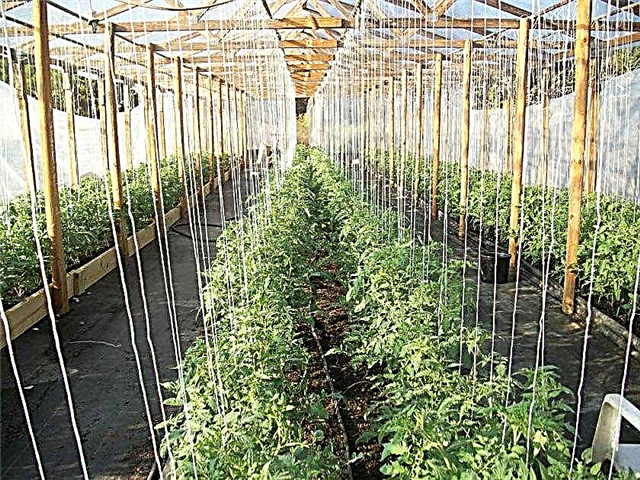
- Using a wire frame. The frame must be in the form of a cylinder or a prism and can be made of wood or metal. The latter material is better suited for cylinder construction. From the wire, you need to make several circles that will surround the frame. Then the circles are welded to the cylinder at an equal distance from each other. The number of circles depends on your wishes and the severity of the plant. A prism is usually made of wooden materials. To encircle the prism, you will no longer need circles made of wire, but squares. It is not necessary to weld the squares to the prism; you can use nails.

Preventative treatment
The king of giants is immune to infections and pests, but not without exception. The first exception is the greenhouse whitefly, which attacks bushes growing in greenhouses, because they retain the level of humidity and temperature that attract the pest. To protect tomatoes from whiteflies, prepare a solution of 150 grams of peeled garlic and a liter of water.
The garlic is crushed, poured with water and left to infuse for 5 days. The resulting tincture is sprayed with bushes. If the whitefly attacked the plants before you took the prophylactic and managed to damage them, you should resort to more serious methods of control - pesticides (Aktara, Aktellik, Fitoverm, Iskra-Bio).
Another exception was fruit rot, which occurs due to bushes that are not tied up in a timely manner. When identifying the primary symptoms of the disease, it is worth treating the plants with Fitoverm, Profit Gold or the Abiga-Peak drug. You can also cope with fruit rot with Bordeaux fluid. To avoid possible infections, it is enough to monitor the conditions in which the tomato develops, feed it with fertilizers on time and follow the rules for caring for the crop.
Harvesting
The King of the Giants variety differs in harvesting rules. Following them, you can extend the shelf life of fruits and maintain their presentation after transportation.

Tomato ripening has stages that are called:
- green
- milk;
- brown;
- pink;
- full (or red).
Important! Tomatoes can be harvested until the ambient temperature drops below + 8 ° C.
Fruits collected during the green and dairy stages are useful in pickling. They can also ripen, but at the height of the season it is not recommended to collect fruits at such an early date. Harvesting at the dairy and brown stages is good for those who are going to transport the crop. In this case, the tomatoes will be slightly immature, which will preserve the presentation of vegetables.
The pink and red ripening stages are recommended for the use of fruits in the near future - eating raw or sending for processing. It is undesirable to transport pink and red crops - the fruits may crack.
The variety must be collected systematically - every 5-7 days. For storing fruits, boxes in which tomatoes can be placed in two or three layers are suitable. After removing the fruit from the stalk, it is enough to clear the soil from the remains, they do not need to be washed.
Did you know? If you put in a box of tomatoes, which have to ripen, a couple of ripe copies - thanks to them, the ripening process will accelerate.
Tomato King of the Giants - a variety that has many advantages, but at the same time needs careful care. Only observing the rules for caring for this plant can achieve high yields and, perhaps, even break the record for the mass of one fruit.










